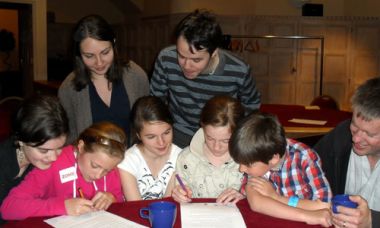Mass migration helping stem church decline in Britain

Mass migration of Christians to Britain from countries such as Poland and Romania is among the factors helping to stem church decline, according to new figures.
The latest analysis of church membership shows a growth in black-led churches and the mainstream churches' "Fresh Expressions" movement have also helped lessen "significantly" the rate of decline.
The fall in church membership previously anticipated for 2020 will now not be evident until 2025, according to the research by Peter Brierley whose second edition of UK Church Statistics is to be published soon.
Brierley said: "This alleviation is due to two major changes over the last few years – the large number of new black and other immigrant churches which have been started, and the increasing success of new gatherings often called 'Fresh Expressions', which is becoming a generic name for all kinds of usually fairly informal gatherings like Messy Church, pub groups or café churches, mission-minded churches, Churches Without Walls (especially in Scotland) as well as those specifically named as Fresh Expressions."
Every single of nearly 300 Christian denominations in the UK was surveyed in mid-2013. These results were referenced against the 2011 Population Census results with the questions on religion, ethnicity and immigration.
Brierley said: "Since many of the immigrants have come from 'Christian' countries, the flow of new people into existing congregations has been notable, as well as resulting in the formation of literally hundreds of new churches. The Black Majority Churches explosion has been significant, especially in Greater London where of the 700 new churches which began between 2005 and 2012, at least 400 were BMCs. The Redeemed Christian Church of God alone has started 296 new churches in the UK in the last five years, the largest number for any single denomination."
He also attributed the slowing decline to the "phenomenal" growth of Fresh Expressions. This movement, formally launched by the Church of England in 2005, is now a collective force drawing many new people in across denominations.
The first volume of UK Church Statistics was based on research done in 2010 and at that time the total UK church membership for 2015 was estimated as 5,190,000 and for 2020 as 4,860,000. In this second volume these figures are estimated respectively as 5,370,000 and 5,040,000 with a 2025 forecast of 4,790,000, these being increases of nearly 4 per cent on the previous 2015 and 2020 figures.
Brierley said: "While these increases are not sufficient to bring overall growth, these two key movements have, however, in effect, pushed the previous rate of decline back by about 5 years."
In 2011, English people were 80 per cent white-British, which means that 20 per cent came from other backgrounds. They also came from a multi-cultural, multi-linguistic and multi-religious background.
This compares to a decade earlier when English people were 88 per cent white-British, meaning that the number of white-British people in England has actually decreased by 3.3 million people between the two Census surveys, while the population as a whole has increased by 1.0 million, giving an extra 4.3 million people in England by 2011 who were not white-British, in addition to the 6.5 million already living here, and giving a grand total of 10.8 million people, or 20 per cent, of the entire population.
In other words the non-white-British contingent in our population increased by two-thirds, 65 per cent, in the 10 years 2001 to 2011, reports Brierley.
"That gives something of the scale of the immigration which has occurred and, because a number of these immigrants are Christian people, or come from countries notionally Christian, an indication of the impact they have had on our church life," he said.
The main denominations affected by this influx of immigrants are Roman Catholics, the Orthodox, the Pentecostals and the many "Overseas Protestant" churches as they are called. Between them these four major groups have more than 50 denominations dedicated to those from overseas countries, some countries having immigrant churches from multiple denominations, such as Polish Catholics and Polish Lutherans, or Romanian Orthodox and Romanian Catholics.
Philip Hughes, writing about ethnicity in Australia, says: "Ethnicity may well have been heightened by the high level of multi-culturalism in Australia. For many people, one of the associations with ethnicity is religion. Hence, religious identification can be a significant carrier for belonging to a particular ethnic group within a multi-ethnic society." Brierley says this is likely to be true in the UK also.
Using the 2011 Population Census figures and the latest membership figures gives a 2011 percentage of immigrants who have become church members of 5.2 per cent.
In 2013 there were 5.4 million church members in the UK, 10 per cent of the adult population, taken as 15 and over, 0.3 million fewer than 5 years previously in 2008 when the percentage was 12 per cent. It is likely to continue to decline at about the same rate for the next 12 years, reaching 9 per cent by 2020 and 8 per cent by 2025 if present trends continue.
But without Fresh Expressions and immigration, church membership would decline even faster in the coming years. "These figures show that church membership in the UK declined by 5 per cent between 2008 and 2013, slightly less than the previous rate of decline, partly because of the impact of immigration and Fresh Expressions," said Brierley. "A broadly similar rate of decline is expected between 2013 and 2020, and thus continues the general trend over the last 60 years. A heart for mission and a willingness to try the new are the key elements here, along with a denominational structure which allows such experimentation and in effect gives its new initiatives permission to fail as well as to succeed. It is obvious that the UK churches are not fossilising and in many instances are still vigorously active!"
UK Church Statistics No 2 2010-2020, edited by Peter Brierley, is published by ADBC Publishers, Tonbridge in August 2014











